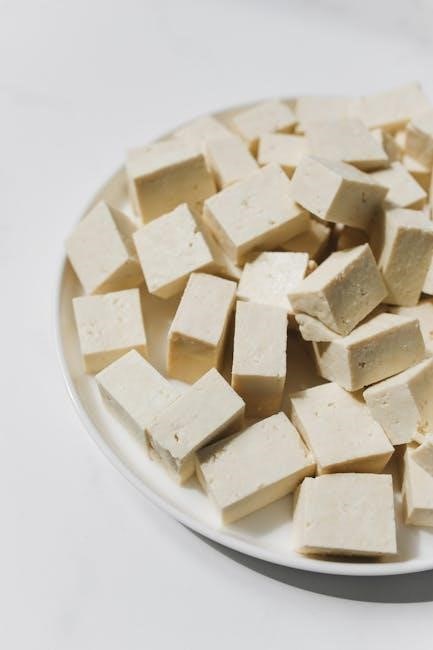
low salicylate diet pdf
A low salicylate diet is a tailored eating plan designed to reduce or eliminate symptoms linked to salicylate sensitivity. It focuses on removing foods high in salicylates‚ naturally occurring compounds found in plants‚ to alleviate discomfort. This approach is often recommended for individuals with conditions like asthma‚ ADHD‚ or mast cell activation syndrome. By understanding salicylate content in foods and following a structured elimination and reintroduction process‚ individuals can manage symptoms and improve overall well-being. This diet requires careful planning but offers significant benefits for those sensitive to these compounds;
What Are Salicylates?
Salicylates are naturally occurring compounds found in plants‚ acting as a defense mechanism. They are present in various foods‚ including fruits‚ vegetables‚ herbs‚ and spices. Salicylates are chemically similar to aspirin and can cause sensitivity in some individuals‚ leading to symptoms like digestive issues or skin rashes. Understanding their presence in foods is crucial for managing sensitivity and implementing a low salicylate diet effectively.
Why a Low Salicylate Diet Might Be Necessary
A low salicylate diet may be essential for individuals experiencing symptoms linked to salicylate sensitivity‚ such as digestive discomfort‚ skin rashes‚ or respiratory issues. By reducing exposure to these compounds‚ the diet can alleviate symptoms and improve quality of life‚ particularly for those with conditions like ADHD‚ asthma‚ or mast cell activation syndrome. It helps manage intolerance effectively and promotes better health outcomes.

Benefits of a Low Salicylate Diet
A low salicylate diet reduces symptoms of intolerance‚ improves conditions like asthma and ADHD‚ and promotes overall well-being by eliminating problematic compounds found in certain foods.
Reducing Symptoms of Intolerance
Adopting a low salicylate diet helps alleviate symptoms such as digestive issues‚ skin rashes‚ and respiratory discomfort. By eliminating high-salicylate foods‚ individuals often experience significant relief from intolerance-related discomfort‚ allowing for better overall health and quality of life. This dietary adjustment is particularly beneficial for those with sensitivities‚ aiding in symptom management and prevention of adverse reactions. Proper planning ensures effectiveness.
Improving Conditions Like Asthma and ADHD
A low salicylate diet can significantly improve conditions such as asthma and ADHD by reducing inflammation and alleviating symptoms. Many individuals report fewer asthma attacks and enhanced respiratory health. For ADHD‚ the diet may lead to better focus‚ reduced hyperactivity‚ and improved emotional regulation. This dietary approach is particularly beneficial for children‚ helping them manage symptoms more effectively and thrive.
How to Start a Low Salicylate Diet
Begin by eliminating high-salicylate foods and focusing on low-salicylate options. Avoid additives and preservatives‚ and consider using digestive enzymes for support. Plan meals carefully to ensure compliance and gradually reintroduce foods to assess tolerance levels. Consult a dietitian for personalized guidance to make the transition smoother and more effective.
Understanding Salicylate Content in Foods
Foods vary widely in salicylate content‚ with highest levels in unripened fruits‚ unpeeled vegetables‚ and certain spices. Medium salicylate foods include some vegetables and grains‚ while low salicylate options like peeled fruits‚ meats‚ and dairy are safer. Recognizing these levels is key to managing a low salicylate diet effectively‚ as natural salicylates are present in many plant-based foods‚ impacting tolerance and symptom management.
Elimination and Reintroduction Process
The elimination phase involves removing high-salicylate foods for 2-4 weeks to assess symptom improvement. Reintroduction occurs slowly‚ testing one food at a time to identify tolerance levels. This method helps pinpoint triggers and establishes a personalized diet plan‚ ensuring long-term symptom management and dietary balance without unnecessary restrictions.
Foods to Avoid on a Low Salicylate Diet
Foods high in salicylates‚ such as colorful fruits‚ vegetables‚ and processed items with additives‚ should be avoided. Ripened and peeled options may reduce salicylate levels slightly.
Foods High in Salicylates
Foods high in salicylates include colorful fruits like berries‚ citrus‚ and tomatoes‚ as well as certain vegetables and spices. Processed foods with additives and unripe or unpeeled produce also contain higher levels.
Foods with Medium Salicylate Levels
Foods with medium salicylate levels include apples‚ pears‚ and certain vegetables like cucumbers and spinach. Some grains and legumes also fall into this category. These foods can be cautiously included in a low salicylate diet‚ depending on individual tolerance levels.
Additives and Preservatives to Avoid
On a low salicylate diet‚ it’s crucial to avoid additives like artificial colors‚ flavors‚ and preservatives‚ such as MSG‚ aspartame‚ and sodium benzoate. These compounds can trigger reactions in sensitive individuals. Always read food labels carefully to identify and eliminate these potential irritants‚ as they may exacerbate symptoms or interfere with the diet’s effectiveness.

Substitutes for High-Salicylate Foods
Finding low-salicylate alternatives is essential for maintaining a balanced diet. Substitute high-salicylate foods with naturally low options like quinoa‚ amaranth‚ and select vegetables to ensure nutritional variety and compliance.
Low-Salicylate Spices and Herbs
Identifying low-salicylate spices and herbs is crucial for flavoring meals without triggering symptoms. Safe options include basil‚ mint‚ parsley‚ and ginger‚ while avoiding high-salicylate choices like curry powder and cumin. Moderation is key‚ as sensitivity varies. Always opt for fresh or single-ingredient products to ensure compliance with the low-salicylate diet and maintain symptom control effectively.
Recipe Adjustments for Compliance
Adapting recipes for a low-salicylate diet involves substituting high-salicylate ingredients with safer alternatives. Replace spices like cumin with basil and swap high-salicylate fruits with options like bananas or pears. Ensure all additives and preservatives are avoided. Using fresh‚ unprocessed foods and checking labels for compliance helps maintain the diet’s effectiveness while keeping meals flavorful and nutritious for long-term symptom management and overall health benefits.
Finding Safe Food Alternatives
Finding safe food alternatives involves identifying low-salicylate substitutes for high-salicylate foods. Swap spices like cumin for basil and choose fruits like bananas or pears. Always check food labels for hidden additives and preservatives. Fresh‚ unprocessed foods are ideal. Printable food lists and online resources can help guide your selection‚ ensuring meals remain both compliant and enjoyable while managing symptoms effectively and safely over time.
Reintroducing Salicylates Safely
Reintroducing salicylates involves a gradual process to test tolerance. Start with small amounts of one food at a time‚ monitoring for symptoms. Allow a few days between introductions to assess reactions. Keep a symptom journal to track changes. This method helps identify safe foods and avoids overwhelming the body. Always consult a healthcare provider before beginning.
Guidelines for Slow Reintroduction
Reintroduce salicylates gradually to assess tolerance. Start with small amounts of low-salicylate foods‚ introducing one at a time. Wait 2-3 days between each new food to monitor reactions. Track symptoms in a journal to identify patterns. If no adverse effects occur‚ slowly increase portion sizes. Be patient‚ as sensitivity can vary. Consult a dietitian for personalized guidance to ensure a safe and effective process.
Monitoring for Tolerance Levels
Track symptoms daily after reintroducing foods to assess tolerance. Note physical reactions like rashes‚ digestive issues‚ or respiratory discomfort. Use a journal to document changes. Allow 2-3 days between food introductions to isolate effects. Adjust portions or remove items causing adverse reactions. Consistency in monitoring helps identify safe foods and maintain symptom control effectively over time.
Managing Symptoms on a Low Salicylate Diet
Identify and document symptom triggers‚ adjusting the diet as needed. Monitor physical and behavioral changes closely. Adjust food portions or eliminate items causing reactions to maintain comfort and health.
Tracking Progress and Symptoms
Tracking progress and symptoms is crucial for managing a low salicylate diet. Keep a detailed journal to record food intake‚ portion sizes‚ and any physical or behavioral reactions. Note improvements or worsening of symptoms‚ such as digestive issues or energy levels. This helps identify triggers and refine the diet. Regular monitoring ensures adjustments align with tolerance levels‚ guiding long-term dietary decisions effectively.
Using Supplements for Support
Supplements can aid in managing symptoms on a low salicylate diet. Digestive enzymes‚ like BioCore‚ may help reduce discomfort during meals. Antihistamines or natural anti-inflammatory agents can alleviate reactions. Consult a healthcare provider before starting any supplements to ensure they align with your health needs and diet goals. Proper supplementation can enhance the effectiveness of the dietary changes and improve overall well-being.
Low Salicylate Diet and Specific Conditions
The low salicylate diet is often beneficial for managing conditions like ADHD‚ asthma‚ and mast cell activation syndrome. It helps reduce inflammation and alleviate symptoms associated with these conditions‚ improving overall quality of life for individuals with sensitivities.
Helping ADHD and Behavioral Issues
The low salicylate diet has shown promise in improving symptoms of ADHD and behavioral challenges. By reducing salicylate intake‚ individuals may experience enhanced focus‚ reduced hyperactivity‚ and calmer demeanor. Parents report noticeable improvements in children’s behavior‚ such as clearer communication and fewer tantrums. This dietary approach can be a valuable strategy for managing ADHD-related difficulties when tailored to individual needs and sensitivities.
Supporting Mast Cell Activation Syndrome
The low salicylate diet can benefit individuals with Mast Cell Activation Syndrome by reducing inflammation and avoiding triggers that may destabilize mast cells. Many with MCAS also experience salicylate sensitivity‚ making this diet a useful strategy to manage symptoms and support overall stability. It helps minimize reactions and promotes a more balanced response to dietary triggers.
Meal Planning and Grocery Shopping Tips
Meal planning and grocery shopping require careful attention to low-salicylate foods‚ reading labels‚ and avoiding additives. A weekly plan and PDF guides can help simplify the process.
Creating a Weekly Meal Plan
Creating a weekly meal plan is essential for maintaining a low-salicylate diet. Plan balanced meals using approved foods‚ ensuring variety and nutrition. Batch cooking and grocery lists can simplify the process. Focus on low-salicylate staples like fresh meats‚ low-salicylate vegetables‚ and safe grains. Use PDF guides or downloadable resources for inspiration and organization. This structured approach helps avoid mistakes and ensures compliance with dietary goals.
Reading Food Labels for Compliance
Reading food labels is crucial for maintaining a low-salicylate diet. Identify hidden sources like additives‚ preservatives‚ and flavorings. Look for terms like “natural flavors” or “spices‚” which may contain salicylates. Use a low-salicylate diet PDF guide to recognize high-risk ingredients. Avoid products with artificial colors or MSG. Always verify the salicylate content of packaged foods to ensure dietary compliance and symptom management.

Seeking Professional Guidance
Professional guidance is key to the success of a low-salicylate diet. Consult a dietitian or healthcare provider for personalized advice on managing symptoms‚ identifying triggers‚ and ensuring nutritional balance.
Role of a Dietitian in the Process
A dietitian plays a crucial role in guiding individuals through a low-salicylate diet. They provide personalized meal plans‚ help identify high-salicylate foods‚ and ensure nutritional adequacy. Dietitians also monitor progress‚ adjust plans as needed‚ and offer strategies to maintain long-term compliance with the diet. Their expertise is invaluable for managing symptoms effectively while promoting overall health and well-being.
When to Consult a Healthcare Provider
Consult a healthcare provider before starting a low-salicylate diet‚ especially if symptoms persist or worsen. They can confirm salicylate sensitivity and rule out other conditions. Seek guidance if symptoms like digestive issues‚ rashes‚ or respiratory problems arise. Providers can tailor the diet to individual needs and monitor progress‚ ensuring safe and effective management of symptoms and underlying conditions.

Low Salicylate Diet PDF Guide
A comprehensive low salicylate diet PDF guide provides detailed food lists‚ meal plans‚ and practical tips for managing salicylate sensitivity. Downloadable resources offer easy access to structured information‚ helping individuals navigate the diet effectively and make informed food choices. These guides are invaluable for those seeking clarity and convenience in implementing a low-salicylate lifestyle.
Downloading Reliable Resources
Downloading a low salicylate diet PDF guide provides a comprehensive resource for managing salicylate sensitivity. These guides typically include detailed food lists‚ meal plans‚ and practical tips for adherence. Many resources are available from healthcare providers or dietitians‚ ensuring credibility. Look for guides that offer structured information to help navigate the diet effectively and make informed choices. Always verify the source for reliability.
Using Printable Food Lists
Printable food lists from a low salicylate diet PDF are essential for easy reference. These lists categorize foods by salicylate levels‚ helping identify safe choices. They often include high‚ medium‚ and low salicylate options‚ making grocery shopping and meal planning simpler. Printable charts can be laminated or placed on the fridge for quick access‚ ensuring adherence to the diet. This tool is invaluable for managing salicylate intake effectively and reducing symptom triggers.

Research and Studies on Salicylate Sensitivity
Studies confirm that a low salicylate diet can alleviate symptoms in sensitive individuals‚ particularly those with ADHD or asthma. Scientific evidence supports its effectiveness in reducing intolerance reactions‚ with research highlighting the importance of personalized approaches to salicylate management. These findings are often detailed in dedicated PDF guides for better understanding and implementation.
Scientific Evidence Supporting the Diet
Scientific studies have demonstrated the effectiveness of a low salicylate diet in reducing symptoms of intolerance and improving conditions like ADHD and asthma. Research highlights how eliminating high-salicylate foods can alleviate reactions‚ with structured dietary approaches showing significant benefits. These findings are well-documented in low salicylate diet PDF guides‚ providing evidence-based support for individuals adopting this dietary plan.
Emerging Research Trends
Recent studies are exploring the broader benefits of a low salicylate diet‚ particularly for conditions like mast cell activation syndrome and histamine intolerance. Emerging trends suggest a link between salicylate sensitivity and neurological disorders‚ with research expanding beyond traditional applications. Advances in personalized nutrition are also highlighting tailored approaches to salicylate management‚ offering hope for more effective symptom relief and improved quality of life.